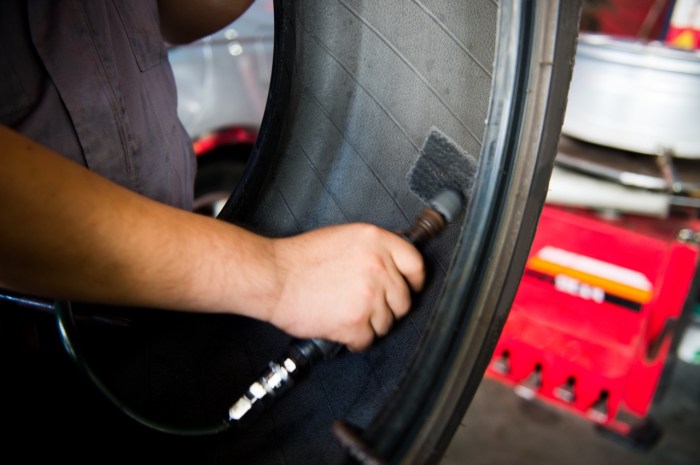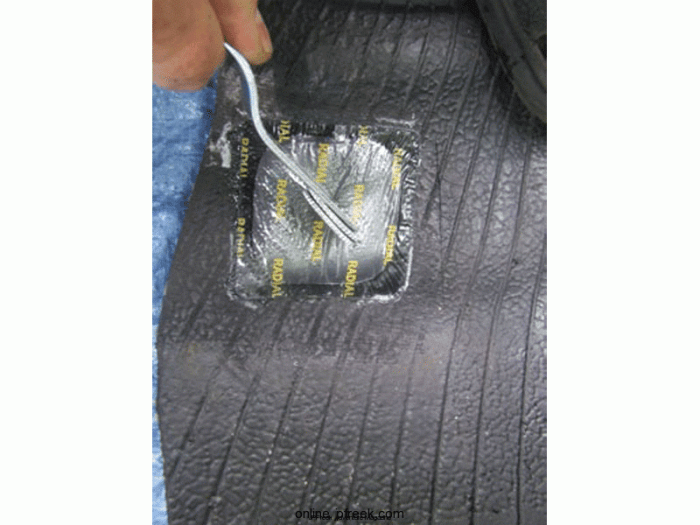How to patch a tire at home? It sounds daunting, but with the right tools and a little know-how, you can save yourself a tow truck bill and some serious frustration. This guide walks you through the entire process, from assessing the damage and gathering supplies to patching the tire and safely reinstalling the wheel. We’ll cover different repair methods, safety precautions, and even show you how to spot when a professional is necessary.
Get ready to become a roadside repair pro!
Changing a tire is a rite of passage for every driver, but knowing how to patch a minor puncture can be a real lifesaver. This guide will cover everything you need to know to successfully patch a tire at home, saving you time and money. We’ll cover various repair kits, explain the differences between plugs and patches, and detail each step with clear instructions and visuals (imagine them here!).
We’ll also address safety concerns and help you determine when a professional is needed. So grab your tools, and let’s get started!
Assessing Tire Damage

So, you’ve got a flat. Bummer. Before you grab your trusty tire patching kit, you need to figure out if this is a DIY job or a call to the pros. Not all tire damage is created equal, and some punctures are simply beyond the scope of a home repair.
Different types of tire punctures vary widely in severity. A small nail puncture, for example, is often easily patched at home. However, a large gash, a sidewall puncture, or damage caused by running over something sharp might require professional attention. Identifying the type of damage is the first step in determining the best course of action.
Tire Puncture Types and Severity
There are several types of tire damage. Small punctures, usually from nails or screws, are the most common and often repairable at home. Larger punctures, significant cuts, or embedded objects might be too extensive for a home repair. Sidewall damage is almost always a job for a professional because the sidewall is a crucial structural component of the tire.
A bulge in the tire sidewall, regardless of the cause, indicates significant structural damage and requires immediate professional attention.
Determining Repairability
Several factors determine whether you can fix a flat tire yourself. First, inspect the tire for the location and size of the puncture. Punctures in the tread area are generally repairable, while sidewall damage is not. If the puncture is large, or if you can see significant damage to the inner liner, professional help is necessary. If the puncture is accompanied by a noticeable bulge or distortion in the tire, it’s likely beyond home repair capabilities.
Necessary Tools and Materials
Having the right tools and materials makes a home tire repair much easier and safer. Here’s a checklist to ensure you’re prepared:
- Tire patching kit (including patches, cement, and rasp)
- Lug wrench
- Jack
- Wheel chocks
- Gloves
- Air compressor or a nearby gas station with an air compressor
Comparison of Tire Repair Kits
Several types of tire repair kits are available, each with its own features and price range. Choosing the right kit depends on your needs and budget.
| Kit Type | Features | Price Range | Pros and Cons |
|---|---|---|---|
| Basic Patch Kit | Patches, cement, rasp | $5 – $15 | Pros: Affordable, simple to use. Cons: May not be suitable for larger punctures. |
| Professional-Grade Patch Kit | Multiple patches, high-quality cement, reamer, instructions | $15 – $30 | Pros: More durable patches, better for larger punctures. Cons: More expensive, requires more skill. |
| Plug and Patch Kit | Plugs for initial sealing, patches for reinforcement | $10 – $25 | Pros: Effective for larger punctures, provides double protection. Cons: Slightly more complex to use than a basic patch kit. |
| Tire Sealant | Liquid sealant injected into the tire | $10 – $20 | Pros: Easy to use, no tools required. Cons: Less permanent than patching, may not work for all punctures. |
Preparing for the Repair
Before you even think about patching that hole, you need to get your car safely prepped. This involves jacking it up, securing it, and removing the wheel. Sounds intense, but it’s pretty straightforward if you follow these steps. Safety first, people!
Jacking Up the Vehicle
Proper jack placement is crucial for safety and preventing damage to your vehicle. Consult your owner’s manual to locate the designated jack points; these are reinforced areas designed to support the weight of your car. Never attempt to jack up your vehicle on any other part of the undercarriage. Position the jack firmly and squarely beneath the designated jack point.
Begin raising the vehicle slowly and steadily, ensuring the jack remains stable throughout the process. You should feel confident in the stability of the jack before proceeding to the next step.
Securing the Vehicle with Jack Stands
Once the tire is slightly off the ground, place jack stands under the vehicle’s frame near the jacked-up wheel. Jack stands are essential safety devices that provide a stable, secondary support point in case the jack fails. They are usually placed just inside the wheel well for optimal support. Carefully lower the vehicle onto the jack stands until the weight is evenly distributed.
Double-check the stability of the jack stands before removing the jack. Never work under a vehicle supported only by a jack.
Wheel Removal
Now that your car is securely supported, you can remove the wheel. First, locate the lug nuts (the bolts holding the wheel onto the hub). Use a lug wrench to loosen them by turning counterclockwise. Don’t remove them completely yet; just break them free. Once loosened, fully unscrew the lug nuts and carefully store them in a safe place, perhaps in a small container, to prevent loss.
Next, gently pull the wheel straight off the hub. You may need a slight tug, but avoid jerking or forcing it.
Deflating the Tire
Before you can patch the tire, you need to completely deflate it. Locate the tire valve stem (the small metal stem protruding from the tire). Use a valve stem remover tool or a sturdy object to carefully depress the valve core. This will allow the air to escape quickly and safely. Let the air escape completely; you should hear a hissing sound.
Once the tire is completely flat, you’re ready to move on to the patching process.
Patching the Tire
Okay, so you’ve assessed the damage, prepped your tools, and now it’s time to actually fix that puncture. This is where the rubber meets the road (pun intended!). We’ll cover both plug and patch methods, highlighting their pros and cons. Remember, safety first – always work in a well-ventilated area and wear appropriate gloves.
Tire repair kits typically come in two varieties: plug kits and patch kits. Plug kits are quicker and simpler for smaller punctures, while patch kits offer a more durable, long-term solution for larger or more serious damage. Let’s dive into the specifics of each.
Using a Tire Plug Repair Kit
Imagine this: You’ve got a small puncture, maybe from a nail or a small piece of glass. A plug kit is your go-to solution. These kits usually include a rasp (a small file), a reamer (to expand the hole), and several rubber plugs coated with adhesive. The process is pretty straightforward.
First, you’ll use the rasp to clean the puncture area, removing any debris. Think of it like prepping a surface before painting – you want a clean, smooth surface for the plug to adhere to. Then, carefully insert the reamer into the hole to slightly enlarge it, creating a slightly tapered hole that will help the plug seat properly.
Next, you’ll take a rubber plug, coat the tapered end with the adhesive, and carefully push it into the hole using the insertion tool provided. Finally, you’ll cut off the excess plug and use the provided abrasive tool to smooth out the surface, making the repair as seamless as possible. The entire process involves a combination of careful cleaning, precise insertion, and finishing touches.
A visual representation would show the rasp removing debris, the reamer enlarging the hole, the adhesive-coated plug being inserted, and the excess plug being trimmed. The final image would show a smooth, repaired tire surface.
Using a Patch Repair Kit
Patch kits are best for larger punctures or when you want a more permanent repair. These kits usually include a rasp, a reamer, and a patch with adhesive. The preparation is similar to the plug repair, starting with cleaning the puncture site with the rasp to remove any debris. Then, use the reamer to create a slightly larger, tapered hole.
This is crucial to ensure a good seal. The key difference is that with a patch kit, you’ll prepare a larger area around the puncture on the inside of the tire. This area is cleaned thoroughly and roughened up to provide a better surface for the adhesive to grip. The patch, which is typically a rubber disc with adhesive, is then applied to the inside of the tire, completely covering the puncture and the surrounding area.
The visual here would start with cleaning the area, reaming the hole, preparing the larger area on the inside, applying the adhesive, pressing the patch in place, and finally showing the completed patch adhered to the inside of the tire.
Plug Repair vs. Patch Repair
Plug repairs are fast, easy, and suitable for minor punctures. However, they are less durable than patch repairs and may not be suitable for larger holes or punctures in the sidewall of the tire. Patch repairs are more time-consuming but provide a more permanent and reliable fix, suitable for larger punctures and often considered safer for high-speed driving. The table below summarizes the key differences.
| Feature | Plug Repair | Patch Repair |
|---|---|---|
| Repair Time | Fast (5-10 minutes) | Slower (15-30 minutes) |
| Durability | Less Durable | More Durable |
| Puncture Size | Small Punctures | Small to Medium Punctures |
| Location | Tread Area | Tread Area (Preferably) |
| Cost | Less Expensive | More Expensive |
Patching a Tire Using a Plug Kit: A Flowchart, How to patch a tire at home
A flowchart visually simplifies the process, making it easy to follow. Each step is clearly represented, guiding you through the repair efficiently and safely.
The flowchart would visually depict the following steps:
- Assess the puncture and gather materials
- Clean the puncture site with the rasp
- Use the reamer to enlarge the hole slightly
- Apply adhesive to the plug
- Insert the plug into the hole using the insertion tool
- Trim the excess plug
- Smooth the surface with the abrasive tool
- Inflate the tire and check for leaks
Reinstalling the Wheel and Tire
Okay, so you’ve patched your tire. Pat yourself on the back – that’s a serious accomplishment! Now it’s time to get that wheel back on your car and get back on the road. This part is crucial for your safety and the longevity of your repair. Let’s make sure we do it right.Reinstalling the wheel involves reversing the steps you took to remove it, but with careful attention to detail.
Properly securing the wheel is paramount to prevent accidents. Remember to always prioritize safety throughout this process.
So, you’re stuck with a flat? Knowing how to patch a tire at home is a super useful life skill, but let’s be real, sometimes you just need to skip the whole thing. If a flat tire’s ruining your vibe, maybe consider upgrading your travel plans with a Private jet and luxury car rental bundles – then you won’t have to worry about punctures! Back to that tire though, make sure you have the right tools before you start patching.
Inflating the Patched Tire
Before you even think about putting the wheel back on, you need to inflate the tire to the correct pressure. This is vital for proper handling and to prevent further damage. Find your vehicle’s recommended tire pressure on the sticker located inside the driver’s side doorjamb or in your owner’s manual. It’ll usually specify the pressure in PSI (pounds per square inch).
Use a reliable tire pressure gauge to check and inflate the tire accordingly. Over-inflation can be just as damaging as under-inflation, so stick to the manufacturer’s recommendation. For example, if the sticker says 32 PSI, aim for that number. Don’t guess; use the gauge!
Reinstalling the Wheel
With the tire properly inflated, align the wheel with the wheel studs on your vehicle’s hub. Push the wheel onto the studs, ensuring it’s flush against the hub. Then, hand-tighten each lug nut in a star pattern (opposite nuts first, then the ones in between) to ensure even pressure. This prevents the wheel from warping as it tightens. Once hand-tightened, use a lug wrench to tighten the nuts further, again following the star pattern, to the manufacturer’s specified torque.
You can find this torque specification in your owner’s manual; failing to tighten to the correct torque can lead to the wheel coming loose while driving.
Lowering the Vehicle
Now, carefully lower your vehicle from the jack stands. Do this slowly and evenly to avoid any sudden drops or shifts that could damage the vehicle or cause injury. Lower the vehicle until the tire is just barely touching the ground, then completely remove the jack stands. Once the vehicle is resting on the ground, give the lug nuts one final check to ensure they are securely tightened.
Post-Repair Inspection and Maintenance
Regularly checking your tire pressure is essential for safe driving. Aim to check it at least once a month, or more often if you frequently drive long distances or in extreme temperatures. Visual inspection is also key. Regularly examine the patched tire for any signs of bulging, cracking, or further damage. If you notice anything unusual, don’t hesitate to get the tire professionally assessed.
So, you’re stuck with a flat? Knowing how to patch a tire at home is a total lifesaver, especially if you’re trying to save up for something awesome, like entering those sweet Luxury car raffle contests 2025. Winning one of those would definitely make patching tires a thing of the past! Anyway, back to the flat – grab your patch kit and let’s get this fixed.
Early detection can prevent a potentially dangerous situation. Remember, your safety depends on maintaining your tires.
Safety Precautions and Considerations

Patching a tire at home can save you time and money, but it’s crucial to prioritize safety. Failing to do so can lead to injury or further damage to your vehicle. This section Artikels essential safety measures and limitations to keep in mind.Proper safety equipment is paramount when working with a jacked-up vehicle and sharp tools. Neglecting these precautions can lead to serious accidents.
Potential Hazards and Safety Measures
Working under a raised vehicle presents inherent risks. Improper jack placement can cause the vehicle to fall, resulting in serious injury. Always use a stable, appropriately rated jack and wheel chocks on the wheels that remain on the ground to prevent the vehicle from rolling. Wear safety glasses to protect your eyes from debris and flying objects. Work gloves will protect your hands from cuts and abrasions.
Never work under a vehicle supported solely by a jack; use jack stands for added security. If you’re unsure about any aspect of the jacking procedure, consult your vehicle’s owner’s manual or seek professional assistance. Furthermore, ensure the area is well-lit and free from obstructions to prevent tripping or falling.
Importance of Proper Safety Equipment
The use of appropriate safety equipment isn’t just a suggestion; it’s a necessity. Safety glasses prevent eye injuries from flying particles or chemical splashes (tire sealant). Heavy-duty work gloves protect your hands from cuts and punctures from the tire’s sharp edges and tools. Jack stands provide a crucial secondary support system, preventing the vehicle from collapsing if the jack fails.
A well-lit workspace improves visibility and reduces the risk of accidents. Ignoring these precautions increases the likelihood of injury or damage.
Limitations of Home Tire Repair and When Professional Assistance is Necessary
Home tire repair is suitable for minor punctures, typically less than ¼ inch in diameter and located in the tire’s tread area. Larger punctures, sidewall damage, or significant wear and tear necessitate professional repair or replacement. If you’re unsure about the extent of the damage, it’s always best to err on the side of caution and seek professional help.
Attempting to repair a severely damaged tire can compromise your safety and lead to a blowout, potentially causing an accident. Additionally, some tires may have internal damage that is not visible externally, necessitating a professional assessment.
Potential Problems and Their Solutions
Several issues might arise during the repair process. For example, the tire may not seal properly after patching, possibly due to improper cleaning or a poorly applied patch. In this case, repeat the cleaning and patching process, ensuring the tire is completely dry and the patch is firmly adhered. Another potential problem is difficulty removing the valve core.
Using a specialized valve core removal tool will help avoid damaging the valve stem. If the tire bead is difficult to seat, ensure proper inflation and use tire irons carefully to avoid damaging the tire or rim. If you encounter significant resistance or damage during any step, stop and seek professional help. For instance, a severely damaged rim might require professional repair or replacement.
Illustrative Examples
Understanding what constitutes a repairable tire puncture versus one requiring professional attention is crucial for safe and effective tire repair. The following examples illustrate the differences and highlight the visual aspects of successful and unsuccessful repairs.
Small Puncture Suitable for Home Repair
Imagine a small nail puncture, about the size of a pinhead, located in the tire tread, about halfway between the sidewall and the center of the tire. The puncture is clean, showing a small, straight hole with no significant tearing or damage to the surrounding rubber. There’s minimal air loss, perhaps a slow leak noticeable over a few days rather than immediate deflation.
This type of puncture is generally considered suitable for a home repair using a plug and patch kit. The location in the tread, away from the sidewall, is key; the tread is thicker and stronger, offering a better anchor for the repair.
Large Puncture or Sidewall Damage Unsuitable for Home Repair
Consider a tire with a large gash, approximately one inch long, located on the sidewall, near the rim. The rubber is severely torn and frayed, and there is significant deformation of the sidewall itself. Air is rapidly escaping, indicating a substantial leak. This type of damage is unsuitable for home repair. The sidewall is a critical structural component of the tire; it supports the weight of the vehicle and flexes during driving.
Any significant damage here compromises the tire’s structural integrity, making it unsafe to drive, even with a repair. Additionally, a puncture caused by a sharp object that penetrated deep into the tire, damaging internal layers, is also unsuitable for a home repair.
Properly Installed Tire Plug and Patch
A properly installed tire plug and patch is barely visible from the outside of the tire. The plug, inserted from the inside, seals the puncture hole. The patch, adhered to the inside of the tire, provides reinforcement and further prevents air leakage. From the outside, you might see only a tiny, almost imperceptible mark where the puncture was. The tire’s tread remains smooth and unbroken, and there is no bulging or deformation around the repair area.
The tire inflates and holds air pressure without any loss.
Improperly Installed Tire Plug or Patch and its Potential Consequences
An improperly installed plug or patch is immediately evident. The patch may be visible from the outside, possibly with uneven edges or a raised area around the repair. The plug might protrude slightly from the tire surface, creating an uneven tread. In severe cases, air might still escape around the plug or patch, causing a slow leak or even sudden deflation.
The tire might also exhibit irregular wear patterns around the repair site. These issues compromise the tire’s structural integrity and can lead to uneven tire wear, reduced handling, potential blowouts, and an increased risk of accidents. An improperly repaired tire could lead to a loss of control, especially at higher speeds.
Final Summary: How To Patch A Tire At Home

Patching a tire at home can be a surprisingly straightforward process, saving you both time and money. By carefully assessing the damage, using the right tools and techniques, and prioritizing safety, you can successfully repair minor punctures and get back on the road. Remember, though, that home repairs have limitations. Knowing when to call a professional is just as important as knowing how to patch a tire yourself.
So, next time you encounter a flat, you’ll be prepared to tackle it head-on (or tire-on?).









